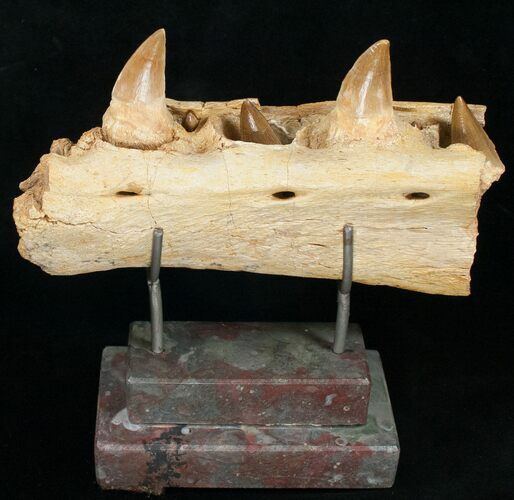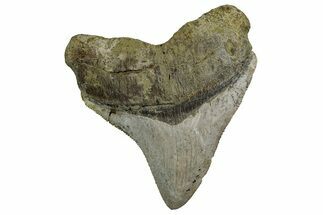This Specimen has been sold.
Mosasaur (Eremiasaurus) Jaw Section On Stand
This is an awe inspiring fossil, a jaw section (yes, a real one) from one of the most fearsome predators to ever inhabit our oceans, the Mosasaur. It comes from the Upper Cretaceous, phosphate deposits in the Oulad Abdoun Basin of Morocco. The jaw section is 5.7 inches long and the largest tooth is about 2.8 inches including the root. There are many different species/genus of Mosasaur in these deposits but this one should be Eremiasaurus heterodontus (LeBlanc, A.R.H., Caldwell, M.W. and Bardet, N. 2012).
Most of the teeth have been remounted with the exception of the one on the left. Teeth are very rarely found in place in Mosasaur jaws. One of the cool aspects of the anatomy shown is you can see the unerupted teeth inside the jaw growing into place. Mosasaurs like sharks and dinosaurs had teeth that replaced themselves as they grew or became worn.
The stone base is made out of fossiliferous rock and you can see fossils of Orthoceras (a straight cephalopod) in it.
You will see hundreds of purported Mosasaurus jaws and jaw sections available at rock shops, shows and online, but nearly 100% of them are fakes. They are crudely constructed using plaster or modern animal bones with real Mosasaurus teeth mounted in them. Real Mosasaurus bones and jaw material like this is quite rare.
Most of the teeth have been remounted with the exception of the one on the left. Teeth are very rarely found in place in Mosasaur jaws. One of the cool aspects of the anatomy shown is you can see the unerupted teeth inside the jaw growing into place. Mosasaurs like sharks and dinosaurs had teeth that replaced themselves as they grew or became worn.
The stone base is made out of fossiliferous rock and you can see fossils of Orthoceras (a straight cephalopod) in it.
You will see hundreds of purported Mosasaurus jaws and jaw sections available at rock shops, shows and online, but nearly 100% of them are fakes. They are crudely constructed using plaster or modern animal bones with real Mosasaurus teeth mounted in them. Real Mosasaurus bones and jaw material like this is quite rare.
Mosasaurs were a family of enormous marine reptiles that truly dominated the seas 90 million years ago, ruling during the last 20-25 million years of the Cretaceous period. With the extinction of the ichthyosaurs and decline of plesiosaurs, mosasaurs diversified to become prolific apex predators in nearly every habitat of the oceanic world.
Larger mosasaurs were the great leviathans of their time, extending 10–15 meters, or 33–49 feet long. Hainosaurus holds the record for the longest mosasaur at a seemingly impossible 57 feet. The smaller genera were still an impressive 10–20 feet long.
Mosasaurs probably evolved from semi-aquatic scaled reptiles, perhaps more similar in appearance to modern-day monitor lizards. They had double-hinged jaws and flexible skulls much like that of a snake which enabled them to gulp down their prey almost whole.
The gruesome unchewed contents of fossilized mosasaur guts have revealed a varied diet of sea birds, ammonites, smaller marine lizards, possibly sharks, and even other mosasaurs. Ammonites were especially crunchy mosasaur treats. They were abundant in the Cretaceous seas, and some mosasaurs had specialized teeth for the job.
Mosasaurs probably lurked for an ambush, rather than hunt, using their powerful tail flukes for extra thrust to dart out and swallow unsuspecting prey. Non-reflective, keeled scales may have been a great advantage to the mosasaur sneak-attack.
Mosasaurs breathed air and gave birth to live young. The bronchi leading to the lungs run parallel to each other, instead of splitting apart from one another as in monitors and other terrestrial reptiles. They were well-adapted to living in the warm, shallow, epicontinental seas of the period.
Although mosasaurs diversified and proliferated at a spectacular rate, their specialization is considered the source of their demise when marine systems collapsed at the end of the Cretaceous.
Larger mosasaurs were the great leviathans of their time, extending 10–15 meters, or 33–49 feet long. Hainosaurus holds the record for the longest mosasaur at a seemingly impossible 57 feet. The smaller genera were still an impressive 10–20 feet long.
Mosasaurs probably evolved from semi-aquatic scaled reptiles, perhaps more similar in appearance to modern-day monitor lizards. They had double-hinged jaws and flexible skulls much like that of a snake which enabled them to gulp down their prey almost whole.
The gruesome unchewed contents of fossilized mosasaur guts have revealed a varied diet of sea birds, ammonites, smaller marine lizards, possibly sharks, and even other mosasaurs. Ammonites were especially crunchy mosasaur treats. They were abundant in the Cretaceous seas, and some mosasaurs had specialized teeth for the job.
Mosasaurs probably lurked for an ambush, rather than hunt, using their powerful tail flukes for extra thrust to dart out and swallow unsuspecting prey. Non-reflective, keeled scales may have been a great advantage to the mosasaur sneak-attack.
Mosasaurs breathed air and gave birth to live young. The bronchi leading to the lungs run parallel to each other, instead of splitting apart from one another as in monitors and other terrestrial reptiles. They were well-adapted to living in the warm, shallow, epicontinental seas of the period.
Although mosasaurs diversified and proliferated at a spectacular rate, their specialization is considered the source of their demise when marine systems collapsed at the end of the Cretaceous.
SPECIES
Eremiasaurus heterodontus
AGE
LOCATION
Oulad Abdoun Basin, Morocco
FORMATION
Phosphate Deposits
SIZE
Jaw section 5.7" long, Largest tooth 2.8" including root
CATEGORY
SUB CATEGORY
ITEM
#11507
We guarantee the authenticity of all of our specimens.
 Reviews
Reviews




















